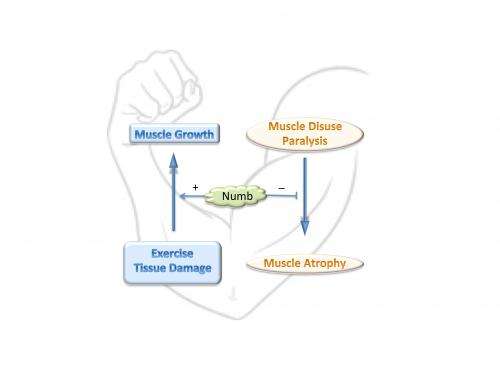Researchers discover new path to address genetic muscular diseases

(Medical Xpress)—For decades, scientists have searched for treatments for myopathies – genetic muscular diseases such as muscular dystrophy and ALS, also called Lou Gehrig's disease. Now, an interdisciplinary team of researchers from ASU, Stanford and University of Arizona has discovered a new avenue to search for treatment possibilities.
The team's research findings are featured in an article in this week's early online edition of the journal Proceedings of the National Academy of Sciences (PNAS).
Under healthy circumstances, individual muscles grow or atrophy based on the demands placed on them. However, in cases of trauma or myopathies, acute muscle loss requires a rapid increase in muscle growth. Such rapid increases are controlled through the activation of an adult stem cell population known as satellite cells. Researchers believe understanding this process is a necessary step toward developing effective therapies for muscle repair.
Jeanne Wilson-Rawls, associate professor in the School of Life Sciences, and her colleagues have examined what role Numb – a gene known to regulate the degradation of proteins – plays in promoting muscle growth.
"Based on the proteins it targets, we believed that Numb sat at the 'decision point' where satellite cells either retained their stemness or became muscle fibers," said Wilson-Rawls. "Now we know that in mice, where the Numb gene was mutated, there was another role for the gene."
The researchers found that Numb suppressed Myostatin, a gene that limits muscle growth and can cause muscle atrophy.
"This makes the gene an ideal target for developing drugs aimed at the therapeutic treatments of muscle loss," added Wilson-Rawls. "Our finding demonstrates the linked nature of the two opposing processes of growth and atrophy and opens new avenues to pursue treatments of muscle diseases," said Wilson-Rawls.
"We also need to consider parallel efforts of suppressing the atrophy signaling pathways, while promoting muscle growth in patients with muscular dystrophy," said Alan Rawls, associate professor with the School of Life Sciences and co-author of the paper.
















